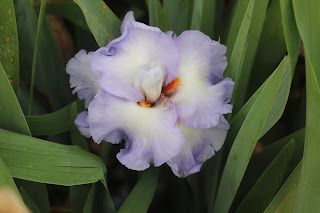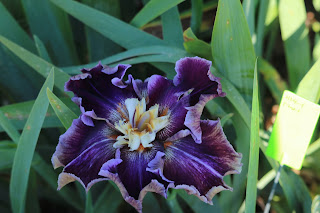Forty-some years ago, when I was a precocious iris-obsessed
teenager, I convinced my mother that our vacation to California to visit my
sister and her family should become a tour of iris hybridizers’ gardens. So it
happened that I ended up in Ben Hager’s living room, with a huge bouquet of ‘Beverly Sills’ on the coffee table, talking irises while my mom and sister politely enjoyed
the ambience and hospitality.
Hager presented a somewhat intimidating figure, with his
bald head, precise beard, and dry wit. He was also something of an iconoclast.
At an after-dinner speech at the 1980 American Iris Society convention in Tulsa, he basically
dismantled the whole premise of the judges’ training program by asserting that judging
irises was an utterly subjective undertaking; and we should give up our
pretensions of authority and just let people like what they like, which is what
we all do anyway.
As a hybridizer, Hager had few equals, in my estimation. He
worked with all classes of irises, and won high awards wherever he turned his
attention. He created the tetraploid miniature tall bearded (MTB) irises almost single-handedly, by sheer
force of will, it seemed. Furthermore, he had a rare combination of
creative, inspired vision coupled with solid knowledge, dogged persistence, and patience. I rank him along with Sir Michael Foster and Paul Cook as one of
the true ground-breakers in the history of iris development.
Today, I want to talk about one of Hager’s grand projects,
an effort to re-create the miniature dwarf bearded (MDB) class, a work that spanned four decades.
In the 1970s, new MDBs were created by hybridizers combining standard dwarf bearded (SDB) with the species Iris pumila in
various combinations. There were basically three possibilities: pure pumila
breeding, pure SDB breeding, and SDB x pumila crosses.
Hager rejected pure pumila breeding (although he did
introduce one, ‘Ceremony’, in 1986) for two reasons. First, being just a single
species, it lacked the genetic variety needed to get the innovative colors,
patterns, and forms that hybridizers crave. Second, he found its growth habit
(mats covered in bloom, like rock-garden plants) to interfere with the appreciation
of the form of the individual iris bloom.
Hager also rejected the SDB x pumila route, although it was
very popular with other MDB hybridizers of the time. The issue here was poor
fertility. Seedlings from this type of cross show only limited fertility, and
are almost impossible to cross amongst themselves, making line breeding an
impossibility. Hager felt strongly that a class of iris can only be improved
and developed if a fertile family can be established, so that breeding can
continue for many generations without fertility barriers arising. He introduced
no MDBs from this type of breeding.
That left pure SDB breeding as a recipe for creating MDBs.
Hager recognized this as the path of greatest promise, but not without
reservations. This is the type of breeding with the greatest variety of colors
and patterns, and the most adaptable to mild-winter climates. MDB-sized seedlings
do arise from SDB x SDB crosses, but they are the exception (most seedlings
will be SDBs like their parents). Hager wanted a more focused program than just
waiting for these happy accidents. He wanted a line of MDBs that would produce
more MDBs, consistently.
He found his answer in his tetraploid MTB work. The
tetraploid MTBs were derived from crossing tall bearded (TB) and border bearded (BB) with the species I. aphylla, a many branched iris
genetically compatible with TBs, although much smaller. Crossing his tetraploid
MTBs with I. pumila, he reasoned,
would produce irises of the same chromosome type as the SDBs, but presumably
consistently smaller. Furthermore, they would be completely fertile with MDBs
from pure SDB breeding, part of the same fertile family. You may read one of Hager's articles on this plan on the DIS website.
 |
| 'Libation' |
 |
| 'Gizmo' |
 |
| 'Prodigy' |
Hager introduced the first MDB of this type, ‘Prodigy’, in
1973. Its pod parent is a seedling of TB ‘Evening Storm’ (Lafrenz, 1953) X I. aphylla ‘Thisbe’ (Dykes, 1923). The
pollen parent is the I. pumila
cultivar ‘Atomic Blue’ (Welch, 1961). It is thus ¼ TB, ¼ aphylla, and ½ pumila.
Next came ‘Libation’ in 1975. It is a child of ‘Prodigy’
crossed with a seedling of MTB ‘Scale Model’ (Hager, 1966) x I. pumila ‘Brownett’ (Roberts, 1957).
Since ‘Scale Model’ is half TB and half aphylla,
‘Libation’ has the same ancestry breakdown as ‘Prodigy’: ¼ TB, ¼ aphylla, and ½
pumila. ‘Libation’ won the Caparne-Welch Award in 1979.
The third and final of these initial progenitors of Hager’s
MDB line is ‘Gizmo’ (1977), with the same parentage as ‘Libation’.
Hager then set about crossing these (and similar seedlings)
with SDBs and MDBs from pure SDB breeding. As such outcrossing progressed, the
amount of aphylla ancestry decreased and the amount of TB ancestry increased.
The goal was to retain the small size conferred by I. aphylla, but bring in the diverse colors and patterns of the
SDBs. Hager now had a line of seedlings specifically designed to consistently
yield fertile MDBs in each generation.
In all, this project produced 34 MDB introductions. Hager
died in 1999, but Adamgrove garden continued to introduce his MDB seedlings
through 2003. Hager also introduced 19 MDBs from pure SDB breeding, and the
above-mentioned pumila ‘Ceremony’.
Here is a list of all 34, grouped by the amount of aphylla
ancestry present in each.
25% I. aphylla
Prodigy (1973), Libation (1975) Caparne-Welch Award 1979, Gizmo
(1977) Caparne-Welch Medal 1987
Between 12% and 24% I.
aphylla
Grey Pearls (1979), Bluetween (1980), Macumba (1988)
Between 6% and 11% I.
aphylla
Footlights (1980), Bitsy (1991), Cute Tot (1999)
Between 4% and 5% I.
aphylla
Pipit (1993), Jiffy (1995), Self Evident (1997)
3% or less I. aphylla
Three Cherries (1971), although not part of this line, is listed
here for completeness, since it has aphylla in its ancestry from the appearance
of TB ‘Sable’ (Cook, 1938) in its pedigree.
Petty Cash (1980), Hot Foot (1982), Bugsy (1993) Caparne-Welch
Medal 2000, Dainty Morsel (1994), Doozey (1994), Fey (1994), Fragment (1995), Hint
(1995), Chaste (1997), Ivory Buttons (1997), Nestling (1997), Trifle (1997), Simple
Enough (1998), Small Thing (R. 1998), Sweet Tooth (1999), Wee Me (1999), In
Touch (R. 1999), Downsized (2001), Dulcet (2001), Pattycake Baker Man (2001), Behold
Titania (2003), Fair Moon (2003), Gallant Youth (2003), Into the Woods (2003), Pirate's
Apprentice (2003)
 |
'Grey Pearls'
photo: El Hutchison |
As far as I can determine, other hybridizers did not take up this
project as Hager had envisioned it, although they did of course use a number of
his irises in their own crosses. My own work with similar crosses has had mixed
results. I cross tetraploid MTBs with pumila each year, but so far have only
bloomed one cross to evaluate, MTB
‘Tic Tac Toe’ (Johnson, 2010) X
I. pumila ‘Wild Whispers’ (Coleman, 2012). The seedlings were all too large for the
MDB class, looking like elongated SDBs or MTBs with deficient bud count. So the
MTB x pumila type of cross is by no means guaranteed to give MDBs in the first
generation.
I do have an interesting MDB seedling from I. aphylla X I. pumila. This
type of cross produced MDB ‘Velvet Toy’ (Dunbar, 1972). My seedling is 5-6
inches in height, and has a distinctive flowering habit. It is branched at the
base like I. aphylla, with both
branches bearing 2 terminal buds each. The four blooms open in succession, at the same height, with no
crowding. It would be nice to see if this trait could be carried on to plants
with a more refined flower. Crossing it with SDB ‘Eye of the Tiger’ (Black, 2008) gave
seedlings that were SDB size or taller, though in a fun variety of color and
pattern. I continue to make crosses with it, mostly selecting smaller MDBs to
pair with it now.
So far, my work with I.reichenbachii X I. pumila seems
the most promising in terms of giving me a consistent MDB line to work with.
Kevin Vaughn has reported good results using Hager’s ‘Self Evident’,
and I have recently acquired this myself, as well as a few others from Hager’s
line.
How should one assess this ambitious program? On some level, it
can surely be deemed a success, as it gave Hager many successful and popular
MDB introductions. Without detailed records from his seedling patch, however,
it is hard to assess how consistent the line was or how much his selection work
over the years contributed to the outcome. Perhaps similar results would have
obtained just by applying the same selection effort to pure SDB lines.
 |
'Self Evident'
photo: Jeanette Graham |
We also have to note that Hager’s tetraploid MTB project is his
most lasting legacy among the bearded irises classes. Tetraploid MTBs are here
to stay, having been taken up by successive generations of hybridizers. The MDB
project did not fare so well, although that may not be any fault of the plants
themselves. Almost all new MDBs today are small selections from pure SDB
breeding, not produced from MDB-specific lines as Hager envisioned. This may
just be a numerical inevitability. There is so much work being done breeding
SDBs that MDBs popping up in SDB seedling patches just can’t help but outnumber
MDBs from the few dedicated lines that hybridizers have worked with. The
situation is reminiscent of that of the BBs, where some good dedicated lines
have been established, but they are still swamped by small selections from TB
crosses, just because so many more TB crosses are made each year.
 |
'Bugsy'
photo: El Hutchison |
If you are interested in hybridizing MDBs, I encourage you to heed
Hager’s wisdom and work toward MDB-specific breeding lines, perhaps using
I. aphylla, perhaps carefully selected
from SDB work, or perhaps using other species.
If you are not a hybridizer, but enjoy growing MDBs in your
garden, please seek out and preserve the Hager MDBs discussed in this post.
They are a window onto a fascinating thread of iris history.
















.png)
.png)
.png)
.png)
.png)





























